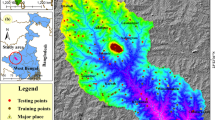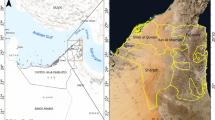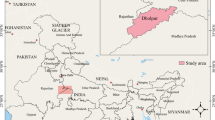Abstract
Khammam district in Telangana, India has gained notoriety for the increasing number of farmer suicides attributed to the augmenting crop failures. Climate change, causing sporadic and uneven rains in the largely agricultural state has increased the strain on the already dwindling water table. Hence, there is a need for an in-depth analysis into the current state of these resources for their sustainable utilization. This study deploys 21 factors for predicting the groundwater potential of the region. An inventory of 126 wells was utilized to construct the dataset with the influencing factors. The statistical method of Frequency ratio (FR) and a machine learning (ML) approach of Gradient Boosted Decision Trees with Greedy feature selection (GA-GBDT) have been applied. GA-GBDT model (accuracy: 81%) outperformed the FR model (accuracy: 63%) and it was deduced that ML has the capability to perform equally well and even better than the traditional statistical approaches in similar studies. The models were utilized to generate groundwater potential maps for the region. The FR model predicted 78 sq.km as having a very high potential to yield groundwater, while GA-GBDT estimated it to be 152 sq.km. The results could play a vital role in irrigation management and city planning.









Similar content being viewed by others
References
Al-Abadi AM, Shahid S (2015) A comparison between index of entropy and catastrophe theory methods for mapping groundwater potential in an arid region. Environ Monit Assess 187(9):576
Al-Abadi AM, Al-Temmeme AA, Al-Ghanimy MA (2016) A GIS-based combining of frequency ratio and index of entropy approaches for mapping groundwater availability zones at Badra–Al Al-Gharbi–Teeb areas, Iraq. Sustainable Water Resources Management 2(3):265–283
Amiri M, Pourghasemi HR (2020) Mapping and preparing a susceptibility map of gully Erosion using the MARS model, In gully Erosion studies from India and surrounding regions (pp. 405–413). Springer, Cham
Ang JH, Teoh EJ, Tan CH, Goh KC, Tan KC (2008, June). Dimension reduction using evolutionary support vector machines. In 2008 IEEE congress on evolutionary computation (IEEE world congress on computational intelligence) (pp. 3634-3641). IEEE
Arabameri A, Pradhan B, Lombardo L (2019) Comparative assessment using boosted regression trees, binary logistic regression, frequency ratio and numerical risk factor for gully erosion susceptibility modelling. Catena 183:104223
Arulbalaji P, Padmalal D, Sreelash K (2019) GIS and AHP techniques based delineation of groundwater potential zones: a case study from southern Western Ghats, India. Sci Rep 9(1):1–17
Bishop CM (2006) Machine learning and pattern recognition
Bonham-Carter, G. F. (2014) Geographic information systems for geoscientists: modelling with GIS (Vol. 13). Elsevier
Bui QT, Nguyen QH, Nguyen XL, Pham VD, Nguyen HD, Pham VM (2020) Verification of novel integrations of swarm intelligence algorithms into deep learning neural network for flood susceptibility mapping. J Hydrol 581:124379
Central Ground Water Board (CGWB), Ministry of Jal Shakti, Department of Water Resources, River Development and Ganga Rejuvenation, Government of India; Assesment of Ground Water (2017) http://cgwb.gov.in/ [Accessed 29 Jan 2020]
Chen W, Li H, Hou E, Wang S, Wang G, Panahi M et al (2018) GIS-based groundwater potential analysis using novel ensemble weights-of-evidence with logistic regression and functional tree models. Sci Total Environ 634:853–867
Choubin, B., Rahmati, O., Soleimani, F., Alilou, H., Moradi, E., & Alamdari, N. (2019). Regional groundwater potential analysis using classification and regression trees. In Spatial modeling in GIS and R for earth and environmental sciences (pp. 485-498). Elsevier
Das S (2019) Comparison among influencing factor, frequency ratio, and analytical hierarchy process techniques for groundwater potential zonation in Vaitarna basin, Maharashtra, India. Groundw Sustain Dev 8:617–629
Ding Q, Chen W, Hong H (2017) Application of frequency ratio, weights of evidence and evidential belief function models in landslide susceptibility mapping. Geocarto international 32(6):619–639
Friedman JH (2002) Stochastic gradient boosting. Computational statistics & data analysis 38(4):367–378
GRAPHIC (Groundwater Resources Assessment under the Pressures of Humanity and Climate Change), UNESCO-IHP project (2015). https://en.unesco.org/groundwaterresourcesandclimate [Accessed 29 January 2020]
Hong H, Chen W, Xu C, Youssef AM, Pradhan B, Tien Bui D (2017a) Rainfall-induced landslide susceptibility assessment at the Chongren area (China) using frequency ratio, certainty factor, and index of entropy. Geocarto international 32(2):139–154
Hong H, Naghibi SA, Dashtpagerdi MM, Pourghasemi HR, Chen W (2017b) A comparative assessment between linear and quadratic discriminant analyses (LDA-QDA) with frequency ratio and weights-of-evidence models for forest fire susceptibility mapping in China. Arab J Geosci 10(7):167
India Today (2019). https://www.indiatoday.in/india/story/243-farmers-committed-suicide-in-telangana-govt-releases-compensation-of-rs-14-58-crore-1576481-2019-08-02 [Accessed 29 January 2020]
Kadavi PR, Lee CW, Lee S (2018) Application of ensemble-based machine learning models to landslide susceptibility mapping. Remote Sens 10(8):1252
Kim JC, Lee S, Jung HS, Lee S (2018) Landslide susceptibility mapping using random forest and boosted tree models in Pyeong-Chang, Korea. Geocarto international 33(9):1000–1015
Kim JC, Jung HS, Lee S (2019) Spatial mapping of the groundwater potential of the Geum River basin using ensemble models based on remote sensing images. Remote Sens 11(19):2285
Krishnamurthy R, Cushman SA, Sarkar MS, Malviya M, Naveen M, Johnson JA, Sen S (2016) Multi-scale prediction of landscape resistance for tiger dispersal in Central India. Landsc Ecol 31(6):1355–1368
Lee S, Pradhan B (2007) Landslide hazard mapping at Selangor, Malaysia using frequency ratio and logistic regression models. Landslides 4(1):33–41
Lee S, Song KY, Kim Y, Park I (2012) Regional groundwater productivity potential mapping using a geographic information system (GIS) based artificial neural network model. Hydrogeol J 20(8):1511–1527
Lee S, Kim JC, Jung HS, Lee MJ, Lee S (2017) Spatial prediction of flood susceptibility using random-forest and boosted-tree models in Seoul metropolitan city, Korea. Geomatics, Natural Hazards and Risk 8(2):1185–1203
Lee S, Lee CW, Kim JC (2019) Groundwater productivity potential mapping using logistic regression and boosted tree models: the case of Okcheon City in Korea, In advances in remote sensing and geo informatics applications (pp. 305–307). Springer, Cham
Lombardo L, Cama M, Conoscenti C, Märker M, Rotigliano EJNH (2015) Binary logistic regression versus stochastic gradient boosted decision trees in assessing landslide susceptibility for multiple-occurring landslide events: application to the 2009 storm event in Messina (Sicily, southern Italy). Nat Hazards 79(3):1621–1648
Mallick J, Singh CK, Al-Wadi H, Ahmed M, Rahman A, Shashtri S, Mukherjee S (2015) Geospatial and geostatistical approach for groundwater potential zone delineation. Hydrol Process 29(3):395–418
Moghaddam DD, Rahmati O, Panahi M, Tiefenbacher J, Darabi H, Haghizadeh A et al (2020) The effect of sample size on different machine learning models for groundwater potential mapping in mountain bedrock aquifers. Catena 187:104421
Moore ID, Burch GJ (1986) Sediment transport capacity of sheet and rill flow: application of unit stream power theory. Water Resour Res 22(8):1350–1360
Moore ID, Grayson RB, Ladson AR (1991) Digital terrain modelling: a review of hydrological, geomorphological, and biological applications. Hydrol Process 5(1):3–30
Naghibi SA, Pourghasemi HR, Pourtaghi ZS, Rezaei A (2015) Groundwater qanat potential mapping using frequency ratio and Shannon’s entropy models in the Moghan watershed, Iran. Earth Sci Inf 8(1):171–186
Naghibi SA, Pourghasemi HR, Dixon B (2016) GIS-based groundwater potential mapping using boosted regression tree, classification and regression tree, and random forest machine learning models in Iran. Environ Monit Assess 188(1):44
Naghibi SA, Moghaddam DD, Kalantar B, Pradhan B, Kisi O (2017) A comparative assessment of GIS-based data mining models and a novel ensemble model in groundwater well potential mapping. J Hydrol 548:471–483
Oh HJ, Lee S (2010) Assessment of ground subsidence using GIS and the weights-of-evidence model. Eng Geol 115(1–2):36–48
Pradhan B (2013) A comparative study on the predictive ability of the decision tree, support vector machine and neuro-fuzzy models in landslide susceptibility mapping using GIS. Comput Geosci 51:350–365
Rahmati O, Pourghasemi HR (2017) Identification of critical flood prone areas in data-scarce and ungauged regions: a comparison of three data mining models. Water Resour Manag 31(5):1473–1487
Rahmati O, Pourghasemi HR, Zeinivand H (2016) Flood susceptibility mapping using frequency ratio and weights-of-evidence models in the Golastan Province, Iran. Geocarto International 31(1):42–70
Razavizadeh S, Solaimani K, Massironi M, Kavian A (2017) Mapping landslide susceptibility with frequency ratio, statistical index, and weights of evidence models: a case study in northern Iran. Environ Earth Sci 76(14):499
Sarkar D, Mondal P (2020) Flood vulnerability mapping using frequency ratio (FR) model: a case study on Kulik river basin, indo-Bangladesh Barind region. Appl Water Sci 10(1):17
Schölkopf B, Smola A, Müller KR (1997, October). Kernel principal component analysis. In international conference on artificial neural networks (pp. 583-588). Springer, Berlin, Heidelberg
Sifa SF, Mahmud T, Tarin MA, Haque DME (2019). Event-based landslide susceptibility mapping using weights of evidence (WoE) and modified frequency ratio (MFR) model: a case study of Rangamati district in Bangladesh. Geology, Ecology, and Landscapes, 1–14
Tehrany MS, Pradhan B, Jebur MN (2014) Flood susceptibility mapping using a novel ensemble weights-of-evidence and support vector machine models in GIS. J Hydrol 512:332–343
Tehrany MS, Pradhan B, Jebur MN (2015) Flood susceptibility analysis and its verification using a novel ensemble support vector machine and frequency ratio method. Stoch Env Res Risk A 29(4):1149–1165
The Hindu (2019). https://www.thehindu.com/news/national/telangana/fall-in-groundwater-hits-rabi-in-many-districts/article26187753.ece [Accessed 29 January 2020]
United Nations Educational, Scientific and Cultural Organization (UNESCO), Water Security, Intergovernmental Hydrological Programme (IHP), Groundwater, (2019). https://en.unesco.org/themes/water-security/hydrology/groundwater [Accessed 29 January 2020]
Were K, Bui DT, Dick ØB, Singh BR (2015) A comparative assessment of support vector regression, artificial neural networks, and random forests for predicting and mapping soil organic carbon stocks across an Afromontane landscape. Ecol Indic 52:394–403
World Bank Report (2012). https://www.worldbank.org/en/news/feature/2012/03/06/india-groundwater-critical-diminishing [Accessed 29 January 2020]
Wu Y, Ke Y, Chen Z, Liang S, Zhao H, Hong H (2020a) Application of alternating decision tree with AdaBoost and bagging ensembles for landslide susceptibility mapping. Catena 187:104396
Wu Z, Zhou Y, Wang H, Jiang Z (2020b) Depth prediction of urban flood under different rainfall return periods based on deep learning and data warehouse. Sci Total Environ 716:137077
Yan F, Zhang Q, Ye S, Ren B (2019) A novel hybrid approach for landslide susceptibility mapping integrating analytical hierarchy process and normalized frequency ratio methods with the cloud model. Geomorphology 327:170–187
Zabihi M, Pourghasemi HR, Motevalli A, Zakeri MA (2019). Gully erosion modeling using GIS-based data mining techniques in northern Iran: a comparison between boosted regression tree and multivariate adaptive regression spline. In Natural Hazards GIS-Based Spatial Modeling Using Data Mining Techniques (pp. 1–26). Springer, Cham
Zuo R, Carranza EJM (2011) Support vector machine: a tool for mapping mineral prospectivity. Comput Geosci 37(12):1967–1975
Author information
Authors and Affiliations
Corresponding author
Ethics declarations
Conflict of Interest
None.
Additional information
Publisher’s Note
Springer Nature remains neutral with regard to jurisdictional claims in published maps and institutional affiliations.
Rights and permissions
About this article
Cite this article
Sachdeva, S., Kumar, B. A Comparative Study between Frequency Ratio Model and Gradient Boosted Decision Trees with Greedy Dimensionality Reduction in Groundwater Potential Assessment. Water Resour Manage 34, 4593–4615 (2020). https://doi.org/10.1007/s11269-020-02677-3
Received:
Accepted:
Published:
Issue Date:
DOI: https://doi.org/10.1007/s11269-020-02677-3




